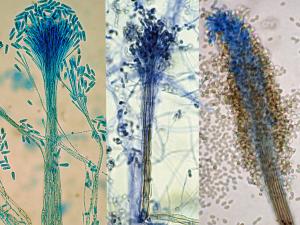Hyphomycetes (Conidial Moulds)
Hyphomyetes are a class of mycelial moulds which reproduce asexually by conidia on hyphae or aggregations of hyphae.

Black rot caused by several common dematiaceous moulds that may also be agents of phaeohyphomycosis.
They were once referred to as Fungi imperfecti or Deuteromycetes, however most are now assigned to the Ascomycota, on the basis of phylogenetic analysis.
In the past mycologists often divided them into two groups; the "hyaline hyphomycetes" those with colourless or brightly coloured colonies or conidia and the "dematiaceous hyphomycetes" those with darkly pigmented colonies or conidia.
-
Laboratory identification
Identification of the hyphomycetes is primarily based on microscopic morphology including; (a) conidial morphology, especially septation, shape, size, color and cell wall texture; (b) the arrangement of conidia as they are borne on the conidiogenous cells, for example are they solitary, arthrocatenate, blastocatenate, basocatenate or gloiosporae etc., (c) the type conidiogenous cell, for example non-specialized or hypha-like, phialide, annellide or sympodial etc., and (d) other additional features such as the presence of sporodochia or synnemata.
Culture characteristics, although less reliable may also be useful. These include surface texture, topography and pigmentation, reverse pigmentation and growth at 37C. For identification, potato dextrose agar and cornmeal agar are two of the most suitable media to use and exposure to daylight is recommended to maximize culture color characteristics.
Key features include microscopic morphology and culture characteristics
It is mandatory to see the conidial characteristics to make an identification therefore you must have a good slide preparation [needle mounts, tape mounts, slide cultures]. May also need to stimulate sporulation by using different media, such as potato dextrose agar or cornmeal agar. If conidia are present then assess the following characters:
1. Conidial characteristics

- Septation [one-celled, two-celled, multicelled with transverse septa only, or multicelled with both transverse and longitudinal septa].
- Shape [spherical, subspherical, pyriform, clavate, ellipsoidal etc].
- Size [need graduated eye piece, length <10μm or >10μm etc].
- Colour [hyaline or darkly pigmented].
- Wall texture [smooth, rough, verrucose, echinulate etc].
- How many conidial types present? [micro and macro].
2. Arrangement of conidia as they are borne on the conidiogenous cells
- Solitary - conidia are formed single in balls.
- Catenulate (conidia arranged in chains).
- Acropetal - catenulate where the youngest conidium at the tip of the chain.
- Basipetal - catenulate where the oldest conidium is at the apex and the youngest is at the base.
Click images below to expand:
3. Growth of the conidiogenous cell
- Determinant conidiophore is where there is no growth of the conidiophore after the formation of conidia.
- Sympodial is a mode of conidiogenous cell growth which results in the development of conidia on a geniculate or zig-zag rachis.
- Retrogressive conidial development is where the conidiogenesis cell becomes shorter during the successive development of conidia.
Click images below to expand:
4. Type of conidiogenous cell present
- Non-specialised.
- Phialide (specialised conidiogenous cells that produces conidia in basipetal succession without increasing in length)
- Annellide (specialised conidiogenous cell producing conidia in basipetal succession by a series of short percurrent proliferations (annellations). The tip of an annellide increases in length and becomes narrower as each subsequent conidium is formed)
- Thallic is a mode of conidial ontogeny where a conidium is formed from a pre-existing hyphal segment or cell.
Click images below to expand:
5. Any additional features present
- Synnemata, Sporodochia, Chlamydoconidia, Pycnidia etc.
- Confirmatory tests for dermatophytes.
Click images below to expand:
6. Culture characteristics

Culture characteristics of Trichophyton rubrum.
Least reliable as the media and growth conditions play an important part. Examine the following characteristics:
Surface texture [glabrous, suede-like, powdery, granular, fluffy, downy, cottony etc].
Surface topography [flat, raised, heaped, folded, domed, radial grooved].
Surface pigmentation [white, cream, yellow, brown, green, grey, black etc].
Reverse pigmentation [none, yellow, brown, red etc].
Growth rate [eg colonies growing less than 5 mm in 14 days etc].
Growth temperature studies are also often very useful [37C, 40C & 45C].
Species descriptions
A list of Mycology references cited for the identification of medically important fungi is available for viewing.











